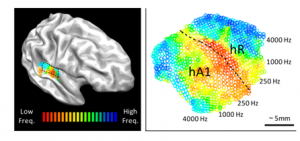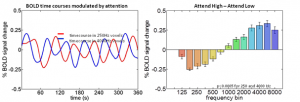Overview
Sound frequencies are preferentially processed by neighboring clusters of neurons in the primary auditory cortex in an orderly arrangement called tonotopy. In this project, we used high-resolution functional MRI at 7 Tesla to map non-invasively the two largest tonotopic areas of the primary auditory cortex (PAC, A1 and R) relative to the underlying anatomy of Heschl’s gyrus (HG). The results were further reproduced with lower field strength ( 3 Telsa).

Both data reveals a clear anatomical–functional relationship that indicates the location of PAC across the range of common morphological variants of HG (single gyri, partial duplication and complete duplication). Human PAC tonotopic subfields are oriented along an oblique posterior-to-anterior axis with mirror-symmetric frequency gradients perpendicular to HG, as in the macaque.

These primary regions are modulated by selective attention to preferred vs. non-preferred sound frequencies in the dynamic manner needed to account for human listening abilities in presence of noisy environments, such as cocktail parties or busy street. We used a dual-stream selective attention experiment where subjects attended to one of two competing tonal streams presented simultaneously to different ears. Attention to low-frequency tones (250 Hz) enhanced neural responses within low-frequency-tuned voxels relative to high (4000 hz), and vice versa when attention switched from high to low. Human PAC is able to tune into attended frequency channels and can switch frequencies on demand, like a radio.

Collaborators
Sandra E. Da Costa
Prof. Stephanie Clarke
Melissa Saenz, DNC, LREN, CHUV, Lausanne
External collaborators
Wietske van der Zwaag, CIBM, EPFL, Lausanne
Funding
Swiss National Science Foundation Grant 3200030-124897


